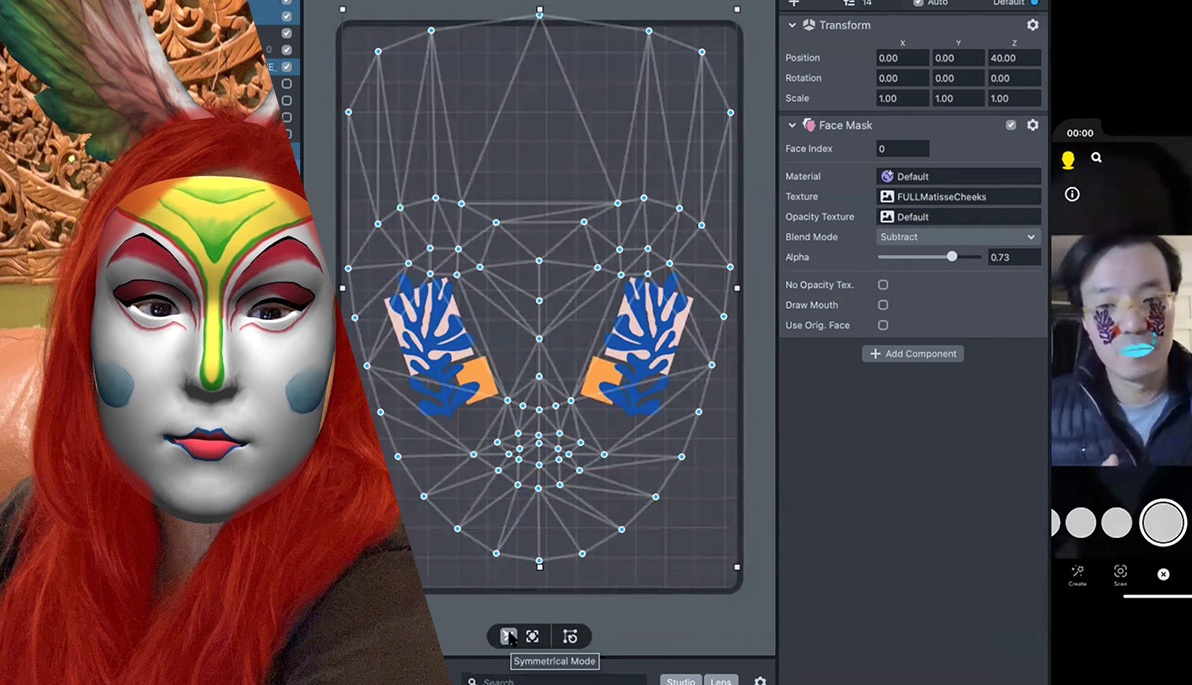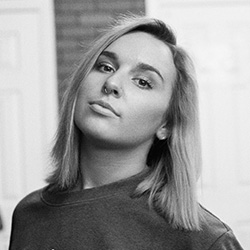News
Helping Animators Augment Their Reality
February 11, 2021
Pictured: Assistant Professor Kevin Park, M.F.A., demonstrates how to create an AR lens in Snapchat’s Lens Studio, while graduate student Dominica Jamir demonstrates the Snapchat AR face paint feature.
In 1908, French artist Émile Cohl created the first animated film, Fantasmagorie. The film was created using one of the earliest examples of traditional hand-drawn animation and featured a cartoon stick figure who encountered morphing objects, such as a wine bottle that transformed into a flower. In its day, Fantasmagorie was considered by audiences as groundbreaking and magical.
Today, animators have access to a wide array of transformative tools to help them create “magic” with moving images—including augmented reality (AR) and smartphones. That was the message that Sung “Kevin” Park, M.F.A., assistant professor of digital art and design, shared with animators at a workshop of the French Institute Alliance Française (FIAF) Animation First festival.
At “Create Your Own Augmented Reality” on February 6, Park, who has more than 20 years of professional experience in the art, design, and emerging tech culture, provided insight on the history and development of AR, explaining how it can transform existing images into moving pictures.
AR enhances images of the physical world using computer-generated inputs, such as sound, video, graphics, GPS overlays, and other features. These inputs can respond in real time to the changes taking place in the user’s environment, often based on the person’s movement.
For example, Lens Studio AR allows Snapchat users to manipulate their environment using lenses and filters. Whereas filters are creative effects that sit on top of an image or video, lenses are playful AR experiences that interact with the user’s environment. These AR animations can change the sound of a person’s voice and manipulate a user’s appearance on the screen (think tongue-wagging puppy dogs and painted faces that move with changing facial expressions). Rivaling Snapchat’s Lens Studio, there is also Facebook’s AR Studio, which went viral when users engaged with its popular “Which Disney Character Are You?” feature.
During his presentation, Park gave attendees an overview of a tool called Spark AR, a platform for Mac and Windows that enables users to create AR effects for mobile cameras. The platform can be helpful to animators as it provides easy-to-use templates and libraries full of assets.
Workshop participants then entered into breakout rooms where they tested Snapchat’s Lens Studio AR technology for themselves. New York Tech faculty, students, and staff demonstrated tips for animators, including how to create lenses. As an entry point to AR, Park recommended that animators use Snapchat’s face-painting feature.
Park was joined by digital art and design graduate students Dominica Jamir, Jung Hee Kim, Shuyi Shao, Twinkle Mohan, Rita Akhmetzianova, and Rebecca Johnson. Brian Lau, digital art and design technical support specialist, also lent his expertise.
As part of the 10-day Animation First festival, New York Tech will host a second event on February 13 called “Why the World Needs Animation.” The event, organized by Associate Professor of Digital Art and Design Michael Hosenfeld, will feature a panel discussion of experts discussing the role of animation in society.




_Thumb.jpg)

